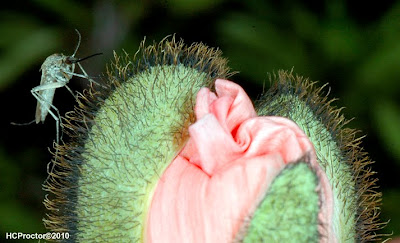I knew it wasn’t good when I saw a flock of sandhill cranes flying south on the evening of 3 May, but April had been anything but a cruel month, so I wasn’t really expecting the blizzard of 4 May. Edmonton’s last frost is expected around 6 May, well, except for that alleged 10% chance of a later one. But then that is the downtown airport predicting and well surrounded by tarmac, buildings, and residual heat. The HBG has had last spring frosts on or before May 6th, but in only 3 of the 8 years for which I have records. There is a difference between frost and blizzard, though, and on 4 May we had the latter with about 20 cm of snow accumulating and followed by about a week of well below “normal” temperatures.
Environment Canada’s Edmonton Temperature “Normals”, presumably means daily high and low temperatures, but means are of little use in this climate. Measures of central tendencies in a truly normal distribution can be informative, but the weather here swings from one extreme to the next, often on a 10-14 [day] roll, and “normal” temperatures are rarely experienced except in passing. The snow stuck around for almost a week, frosts and flurries dominated the well below normal weather, and things looked bleak for the early bloomers and recently transplanted perennials.
But what do I know – except for a few burned branch tips and blasted tulips, most plants came through just fine. What most impressed me was the palm-leafed coltsfoot Petasites frigidus palmatus. Some plants avoid damage to their cells from ice crystals by shedding water when the temperatures plunge. This causes a loss of turgor - leaves and herbaceous stems become limp. Under the snow and even after the snow finally melted but the temperatures remained low, the coltsfoot looked like it had been beaten down by the weather. But it was just doing the obligatory obeisance to the Frost Gods. Perhaps to the Aztec god Itztlacoliuhqui, which Wikipedia tells me is best translated as "Everything Has Become Bent by Means of Coldness".








20cm of snow on May 4? We are well past last freeze date by then. But then, you get to see flocks of sandhill cranes.
ReplyDeleteMozzies - mosquitoes I presume? What do you call deer flies - dozzies? (sorry!)
I threw a towel over my trays of perennials for a week and they held up fine. However, my tomato plant is potted now and I don't want to have to run out and baby it - so no more snow or frost, please!
ReplyDeleteHi Ted - Australians would call tabanids March Flies, of course! Queensland has quite a diversity of them, but I can't remember anything that looked like a Chrysops. I did some googling and most hits were for the Yellow-faced Honeyeater (Lichenostomus chrysops), but did find one paper describing the immatures of 2 New Guinea Chrysops. Two other species apparently occur in Australia.
ReplyDeleteHi Garden Ms S:
ReplyDeleteThe only plants I'm sure I lost to the blizzard were some of the early volunteer seedlings - red orache, for example. It was everywhere before the cold spell, but gone now. Well, I bet there will be more sprouts - it is a bit weedy.
My tomatoes, tomatillos, and a few herbs are in the ground but protected by granny skirts (pink tubes of water). They look incredibly tacky, but give me a chance to extend the growing season a bit and reduce the fretting and worry every time the thermometer plunges.